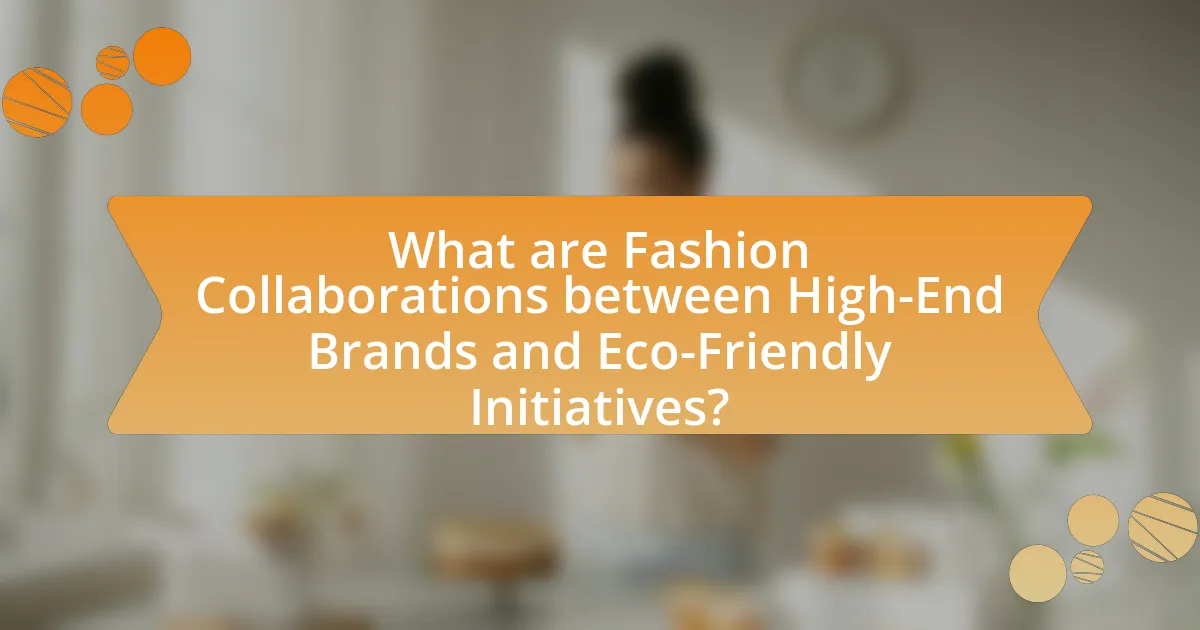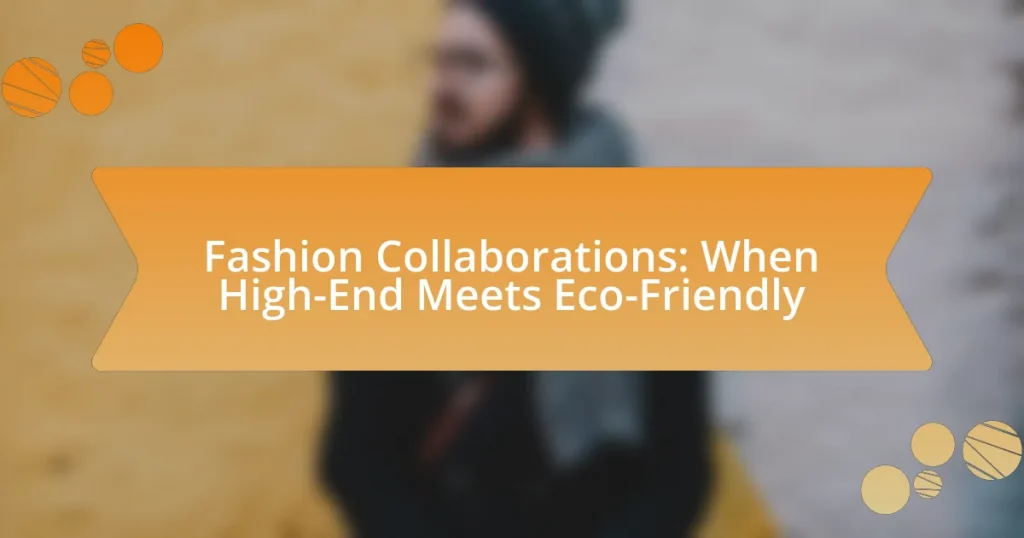Fashion collaborations between high-end brands and eco-friendly initiatives represent a significant trend in the luxury fashion industry, aimed at promoting sustainability through partnerships that utilize sustainable materials and ethical production practices. These collaborations, exemplified by brands like Stella McCartney and Gucci, not only enhance brand image but also respond to the increasing consumer demand for environmentally responsible products. Key characteristics include a commitment to luxury craftsmanship, innovative design, and transparency in sourcing and production. The article explores how these collaborations redefine industry standards, influence consumer behavior, and highlight the challenges and opportunities within the realm of sustainable fashion.

What are Fashion Collaborations between High-End Brands and Eco-Friendly Initiatives?
Fashion collaborations between high-end brands and eco-friendly initiatives are partnerships aimed at promoting sustainable practices within the luxury fashion industry. These collaborations often involve high-end designers working with environmentally conscious organizations or using sustainable materials to create limited-edition collections. For instance, Stella McCartney has collaborated with organizations like the World Wildlife Fund to raise awareness about sustainability while producing eco-friendly garments. Such partnerships not only enhance brand image but also contribute to a growing movement towards responsible fashion, as evidenced by the increasing consumer demand for sustainable products, which has risen by 71% in the past five years according to a report by McKinsey & Company.
How do these collaborations redefine the fashion industry?
Collaborations between high-end brands and eco-friendly initiatives redefine the fashion industry by integrating sustainability into luxury. These partnerships challenge traditional notions of exclusivity by promoting environmentally conscious practices, thereby appealing to a growing consumer base that values ethical production. For instance, brands like Stella McCartney have successfully merged high fashion with sustainable materials, demonstrating that luxury can coexist with eco-friendliness. This shift not only influences consumer purchasing decisions but also encourages other brands to adopt sustainable practices, ultimately transforming industry standards and expectations.
What are the key characteristics of high-end and eco-friendly fashion collaborations?
High-end and eco-friendly fashion collaborations are characterized by a commitment to sustainability, luxury craftsmanship, and innovative design. These collaborations often utilize sustainable materials, such as organic cotton, recycled fabrics, and biodegradable components, which reduce environmental impact. Additionally, they emphasize ethical production practices, ensuring fair labor conditions and minimizing waste throughout the supply chain.
The luxury aspect is maintained through meticulous attention to detail, superior quality, and exclusive designs that appeal to discerning consumers. For instance, brands like Stella McCartney have successfully merged high fashion with eco-consciousness, demonstrating that sustainability can coexist with luxury. This approach not only attracts environmentally aware consumers but also sets a precedent for the industry, encouraging other brands to adopt similar practices.
How do consumer perceptions influence these collaborations?
Consumer perceptions significantly influence collaborations between high-end and eco-friendly fashion brands by shaping their marketability and consumer acceptance. Positive consumer perceptions of sustainability can enhance the appeal of these collaborations, leading to increased sales and brand loyalty. For instance, a study by Nielsen found that 66% of global consumers are willing to pay more for sustainable brands, indicating that favorable perceptions of eco-friendliness can drive purchasing decisions. Additionally, collaborations that resonate with consumer values, such as environmental responsibility, can enhance brand reputation and attract a broader audience, ultimately impacting the success of the partnership.
Why are fashion collaborations important for sustainability?
Fashion collaborations are important for sustainability because they combine resources and expertise from multiple brands to create eco-friendly products. This synergy allows for innovative approaches to sustainable materials and production methods, reducing waste and environmental impact. For instance, collaborations like Stella McCartney and Adidas have led to the development of sustainable fabrics, such as recycled polyester, which significantly lowers the carbon footprint compared to traditional materials. By pooling knowledge and capabilities, these partnerships can accelerate the transition to a more sustainable fashion industry, making eco-conscious choices more accessible to consumers.
What role do high-end brands play in promoting eco-friendly practices?
High-end brands play a significant role in promoting eco-friendly practices by setting industry standards and influencing consumer behavior towards sustainability. These brands often invest in sustainable materials, ethical production processes, and transparent supply chains, which not only reduce environmental impact but also enhance their brand image. For instance, luxury fashion houses like Stella McCartney have pioneered the use of organic cotton and recycled materials, demonstrating that high-quality fashion can coexist with eco-consciousness. Additionally, high-end brands frequently collaborate with environmental organizations and participate in initiatives like the Fashion Pact, which aims to reduce the fashion industry’s carbon footprint. Such actions not only showcase their commitment to sustainability but also inspire other brands to adopt similar practices, thereby amplifying the overall impact on the industry.
How do these collaborations impact environmental awareness among consumers?
Collaborations between high-end fashion brands and eco-friendly initiatives significantly enhance environmental awareness among consumers. These partnerships often leverage the prestige and visibility of luxury brands to promote sustainable practices, thereby reaching a broader audience. For instance, when brands like Stella McCartney collaborate with organizations focused on sustainability, they not only introduce eco-friendly materials but also educate consumers about the environmental impact of their purchasing decisions. Research indicates that 66% of consumers are willing to pay more for sustainable brands, highlighting a growing awareness and demand for environmentally responsible fashion choices.

What are some notable examples of High-End and Eco-Friendly Fashion Collaborations?
Notable examples of high-end and eco-friendly fashion collaborations include Stella McCartney’s partnership with Adidas, which focuses on sustainable materials and ethical production practices. Another significant collaboration is between Gucci and The RealReal, promoting circular fashion by encouraging the resale of luxury items. Additionally, H&M’s Conscious Exclusive line features collections made from organic and recycled materials, showcasing high fashion with an eco-conscious approach. These collaborations highlight the growing trend of integrating sustainability into luxury fashion, reflecting consumer demand for environmentally responsible practices.
Which brands have successfully merged luxury with sustainability?
Brands that have successfully merged luxury with sustainability include Stella McCartney, Gucci, and Prada. Stella McCartney is renowned for its commitment to vegan materials and sustainable practices, having launched the “Stella McCartney Cares” initiative to promote eco-friendly fashion. Gucci has implemented the “Gucci Equilibrium” program, focusing on reducing its environmental impact and promoting social responsibility, achieving carbon neutrality in its operations. Prada has introduced the “Prada Re-Nylon” line, which utilizes recycled nylon made from ocean plastic and other waste, showcasing its dedication to sustainability while maintaining luxury aesthetics. These brands exemplify how high-end fashion can align with eco-conscious values.
What innovative materials and practices have been introduced through these collaborations?
Innovative materials and practices introduced through high-end and eco-friendly fashion collaborations include the use of recycled fabrics, organic cotton, and biodegradable materials. For instance, brands have developed textiles made from recycled plastic bottles, significantly reducing waste and promoting sustainability. Additionally, practices such as zero-waste design and circular fashion models have emerged, emphasizing the importance of reusing and recycling materials throughout the production process. These collaborations often highlight the integration of eco-conscious manufacturing techniques, such as waterless dyeing and energy-efficient production methods, which further contribute to reducing the environmental impact of fashion.
How have these collaborations influenced brand loyalty and consumer behavior?
Collaborations between high-end and eco-friendly brands have significantly influenced brand loyalty and consumer behavior by aligning luxury with sustainability. This alignment attracts environmentally conscious consumers who prioritize ethical practices, thereby enhancing brand loyalty among this demographic. For instance, a study by McKinsey & Company in 2021 found that 67% of consumers consider sustainability when making purchasing decisions, indicating a shift in consumer behavior towards brands that demonstrate social responsibility. Additionally, collaborations often create unique product offerings that generate excitement and exclusivity, further driving consumer engagement and loyalty.
What challenges do high-end brands face in eco-friendly collaborations?
High-end brands face significant challenges in eco-friendly collaborations, primarily due to the high costs associated with sustainable materials and production processes. These brands often prioritize luxury and exclusivity, which can conflict with the principles of sustainability that emphasize cost-effectiveness and accessibility. Additionally, high-end brands may struggle with supply chain transparency, as sourcing eco-friendly materials often requires extensive verification of ethical practices, which can be complex and time-consuming. Furthermore, consumer skepticism about the authenticity of eco-friendly claims can hinder brand reputation, as customers may question whether high-end brands are genuinely committed to sustainability or merely engaging in greenwashing. According to a 2021 McKinsey report, 67% of consumers consider sustainability when making luxury purchases, highlighting the importance of genuine eco-friendly practices for brand loyalty.
How do cost and production limitations affect these partnerships?
Cost and production limitations significantly impact partnerships in the fashion industry, particularly in high-end and eco-friendly collaborations. These limitations can restrict the ability to source sustainable materials, which often come at a higher price point, thereby affecting the overall budget and pricing strategy of the collaboration. For instance, brands may struggle to maintain their luxury image while adhering to eco-friendly practices that require more expensive, ethically sourced materials. Additionally, production limitations, such as the capacity of sustainable manufacturers, can lead to delays and increased costs, further complicating the partnership dynamics. According to a report by McKinsey & Company, the sustainable fashion market is projected to grow, but brands face challenges in scaling production without compromising on sustainability, which underscores the critical nature of cost and production constraints in these collaborations.
What are the potential pitfalls of greenwashing in fashion collaborations?
The potential pitfalls of greenwashing in fashion collaborations include consumer distrust, reputational damage, and regulatory scrutiny. When brands falsely claim sustainability, consumers may feel misled, leading to a loss of trust and loyalty. For instance, a 2021 survey by the Global Fashion Agenda found that 77% of consumers are concerned about greenwashing, indicating a significant risk for brands that engage in deceptive practices. Additionally, brands that are caught greenwashing can face backlash on social media, resulting in negative publicity and long-term damage to their reputation. Furthermore, regulatory bodies are increasingly scrutinizing marketing claims related to sustainability, which can lead to legal consequences for brands that do not substantiate their eco-friendly assertions.

How can consumers engage with High-End and Eco-Friendly Fashion Collaborations?
Consumers can engage with high-end and eco-friendly fashion collaborations by actively participating in brand events, purchasing limited-edition items, and following brands on social media for updates. Engaging in brand events allows consumers to experience the collaboration firsthand, while purchasing limited-edition items supports sustainable practices and promotes eco-conscious brands. Following brands on social media keeps consumers informed about new releases and initiatives, fostering a community around sustainable fashion. According to a report by McKinsey & Company, 67% of consumers consider sustainability when making a purchase, highlighting the growing importance of eco-friendly collaborations in consumer decision-making.
What should consumers look for when choosing sustainable fashion collaborations?
Consumers should look for transparency in sustainable fashion collaborations. Transparency includes clear information about the sourcing of materials, production processes, and labor practices. For instance, brands that disclose their supply chain details and adhere to ethical labor standards demonstrate a commitment to sustainability. Additionally, certifications such as Global Organic Textile Standard (GOTS) or Fair Trade can serve as indicators of a brand’s dedication to environmentally friendly practices. Research shows that consumers increasingly prefer brands that prioritize sustainability, with 66% of global consumers willing to pay more for sustainable brands, according to a Nielsen report. This data underscores the importance of informed choices in sustainable fashion.
How can consumers support brands that prioritize eco-friendly practices?
Consumers can support brands that prioritize eco-friendly practices by choosing to purchase their products and advocating for sustainable practices. By selecting eco-friendly brands, consumers contribute to the demand for sustainable materials and ethical production methods. Research indicates that 66% of global consumers are willing to pay more for sustainable brands, demonstrating a clear market preference for eco-conscious products. Additionally, consumers can engage with these brands on social media, share their positive experiences, and encourage others to make sustainable choices, further amplifying the impact of eco-friendly practices in the fashion industry.
What are the benefits of investing in sustainable fashion pieces?
Investing in sustainable fashion pieces offers numerous benefits, including environmental conservation, ethical labor practices, and long-term cost savings. Sustainable fashion reduces waste and pollution by utilizing eco-friendly materials and production methods, which helps mitigate climate change. Additionally, brands that prioritize sustainability often ensure fair wages and safe working conditions for their workers, promoting social responsibility. Over time, sustainable pieces tend to be of higher quality and durability, leading to fewer replacements and ultimately saving consumers money. According to a report by the Ellen MacArthur Foundation, the fashion industry could reduce its greenhouse gas emissions by 1.1 billion tons annually by adopting sustainable practices, highlighting the significant positive impact of such investments.
What are the future trends in High-End and Eco-Friendly Fashion Collaborations?
Future trends in high-end and eco-friendly fashion collaborations include increased use of sustainable materials, innovative recycling technologies, and a focus on transparency in supply chains. High-end brands are increasingly partnering with eco-conscious designers to create collections that prioritize environmental responsibility while maintaining luxury aesthetics. For instance, the rise of biodegradable fabrics and upcycled materials is becoming more prevalent, as seen in collaborations like Stella McCartney’s work with Adidas, which emphasizes sustainable practices. Additionally, consumer demand for ethical fashion is driving brands to adopt circular economy principles, ensuring that products are designed for longevity and recyclability. This shift is supported by research indicating that 66% of consumers are willing to pay more for sustainable brands, highlighting the market potential for eco-friendly collaborations.
How might technology influence the evolution of these collaborations?
Technology will significantly influence the evolution of fashion collaborations by enhancing communication, streamlining production processes, and enabling innovative design practices. Advanced digital tools, such as 3D modeling and virtual reality, allow designers to visualize and prototype eco-friendly materials more efficiently, reducing waste and time in the development phase. Additionally, platforms for real-time collaboration facilitate partnerships between high-end brands and sustainable manufacturers, fostering transparency and ethical practices. For instance, the use of blockchain technology can track the supply chain, ensuring that eco-friendly claims are verifiable, which is increasingly important to consumers. This integration of technology not only promotes sustainability but also drives consumer engagement through interactive experiences and personalized marketing strategies.
What emerging brands are leading the way in sustainable luxury fashion?
Emerging brands leading the way in sustainable luxury fashion include Reformation, Stella McCartney, and Etnies. Reformation is known for its eco-friendly practices, using sustainable materials and transparent supply chains, which has garnered a loyal customer base. Stella McCartney has been a pioneer in sustainable luxury since its inception, focusing on cruelty-free materials and innovative recycling methods. Etnies, while primarily a footwear brand, emphasizes sustainability through its use of recycled materials and commitment to reducing carbon footprints. These brands exemplify the integration of luxury and sustainability, setting new standards in the fashion industry.
What practical tips can consumers follow to make informed choices in sustainable fashion?
Consumers can make informed choices in sustainable fashion by researching brands’ sustainability practices, prioritizing quality over quantity, and opting for second-hand or upcycled clothing. Researching brands involves checking their transparency regarding materials, labor practices, and environmental impact, as many sustainable brands provide detailed information on their websites. Prioritizing quality ensures that garments last longer, reducing waste; for instance, clothing made from organic cotton or recycled materials often has a lower environmental footprint. Additionally, purchasing second-hand clothing can significantly decrease demand for new production, which is a major contributor to environmental degradation. According to a report by the Ellen MacArthur Foundation, extending the life of clothing by just nine months can reduce carbon, water, and waste footprints by around 20-30%.



